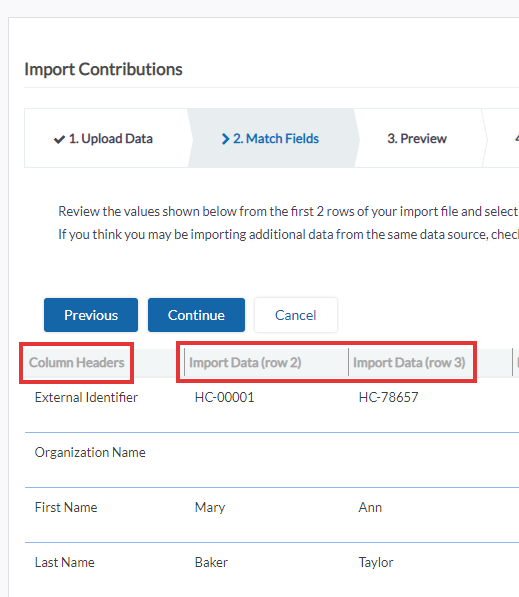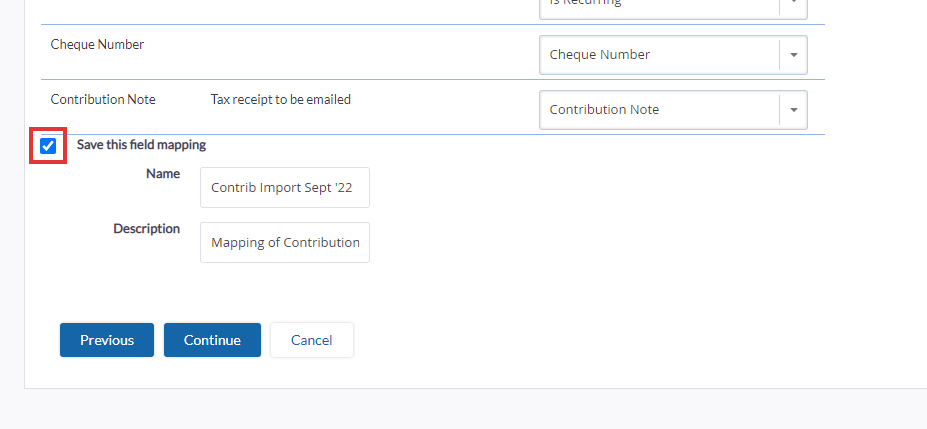Donor Management System
This article will cover how to import a large number of Contributions into your DMS at once using the Bulk Import tool for Contributions.
Please note that before importing contributions into your donor management system, the contacts associated with these contributions must already be in your database. If the contacts do not yet exist, we recommend reviewing our article on importing contacts in bulk for guidance. Once you've confirmed that all relevant contacts are in the system, you can proceed to map the contributions to their profiles using either the contact ID or external ID.
Preparing for Import
1. Download our two handy Data Templates, and use them as guides when preparing your Contribution data for import. All you have to do is copy the Template column names, and paste them directly into your data's corresponding columns.
Importer Template for Contributions- Individuals
Importer Template for Contributions- Organizations
Tip: Pay special attention to columns labelled Mandatory (green) and Recommended (yellow), so you can be sure to include the information that the DMS needs in order to map your Contributions successfully.
If they aren't relevant to your import, feel free to leave out any Optional (grey) columns from your import file.
2. For a successful import, your Contributions must be sorted by Contact Type (i.e., Individuals and Organizations). For this, simply sort your Contribution data into two separate .CSV files (one file for Individuals, and one file for Organizations; see two templates above). You can then perform two separate imports (one for each .CSV file) following the instructions in this article.
3. Finally, you'll want to ensure that the data you'll be importing is saved as a Comma-Separated Values (.CSV) file:

Accessing the Import Tool
Once you've finished organizing your Contribution data based on the Template/s above, you're ready to start the import into your DMS!
1. Login to your DMS and visit the Contributions tab
2. Under Advanced Actions on the right, select Bulk Import Contributions.
 Bulk Import Contributions
Bulk Import Contributions
Note: Don't see the Bulk Import tool for Contributions in your DMS? Reach out to our team at info@canadahelps.org and we'll get you set up!
3. On the next page, you'll see the four steps required to import your Contributions:
 Four steps to complete the import
Four steps to complete the import
Importing Your Contributions
Step 1: Upload Data
1. The Data Source field will be pre-selected for you as Comma-Separated Values (.CSV) format.
2. Click on Choose File and select the data file you'd like to import
3. If your data file has column headers (e.g., Amount, Campaign), check off First row contains column headers to ensure that your headers aren't imported as a Contribution (but rather used to map your data).
Note: If your data file doesn't have any headers (i.e., the first row contains Contribution information and not column names), leave this box unchecked.
 Upload your data
Upload your data
4. Tell the system what type of Contact (Individuals or Organizations) the Contributions correspond to.
Reminder: The Import tool requires Contributions to be imported separately by Contact Type. See Preparing for Import (point 3) above for more information.
 Importing by Contact Type
Importing by Contact Type
5. Select an Import mode to indicate whether the Import tool will be creating new Contributions or updating existing Contributions in your DMS.
 Import modes
Import modes
Note: When updating existing Contributions, please include the Transaction ID, Date Received, Total Amount, and Fund fields in your file.
These are required fields that help the Import tool identify the correct existing Contributions and update them with any new information.
 Select the date format used in your data files
Select the date format used in your data filesNote: If your data contains a different date format that what you've selected, it'll be flagged as an error in the Preview step.
-----
Step 2: Match Fields
1. If you've selected First row contains column headers (step 3 above), your column headers should now show up under Column Names and your first row's data under Import Data (row 1) (and so on).
 Column Names + Rows
Column Names + Rows2. Based on the file uploaded, the Import Tool will automatically suggest the Matching DMS Field that corresponds to your rows, but you can always look for/edit a field by selecting the drop-down arrow.
 Matching your fields to the DMS fields
Matching your fields to the DMS fields
Note: As you'll see in either of the Contribution Data Templates (provided above), we recommend using unique fields (e.g., Contact ID, External ID) to match Contributions to Contacts.
3. Use the Save this field mapping checkbox at the bottom of your screen to save these mapped fields and avoid having to map them again (e.g., should you need to upload an updated file to correct any errors; see Step 4: Summary below).
 Save Field Mapping
Save Field Mapping4. If you do choose to save your field mapping, in the future, you'll be able to find it in the drop-down menu on Step 1. Upload Data:
 Accessing a previously-saved Field Mapping
Accessing a previously-saved Field Mapping
------
Step 3: Preview
The Preview step serves as the final confirmation page before submitting your data for bulk import.
1. If there are any preliminary errors with your data, the Import Tool will prompt you to download a list of records that require editing before proceeding to the final step.
2. To see and update these errors, click the Download Errors link to download the CSV file, where you'll find the errors under Column B.
 Preview Fields
Preview Fields3. Note: If you opt to proceed with the import without correcting any errors, any rows with errors will not be imported.
 Importing without correcting errors
Importing without correcting errors
-----
Step 4: Summary
This is the final step of your data import. Hooray!
1. If there were no errors with the import, the number of Total Rows will match the Records Imported. If this is the case, you can select Done, as there's no further action required of you.
 Successful import
Successful import2. On the other hand, if the Import tool detected any errors (e.g., formatting errors) during the import, it'll produce a file/s for you to download and review:
 Import errors
Import errors
3. Depending on the amount of records needing correction, you can decide how you'd like to proceed:
- You can download your errors, make any necessary changes to your data, and repeat the import steps above; OR
- If there are few errors, you may want to simply add these Contributions records manually instead
Questions?
If you have any questions as you complete the Bulk Import, don't hesitate to contact our team. That's what we're here for!
What's Next?
If you've finished with all of your bulk importing, go ahead and check out all of your newly-imported Contribution data in your DMS!
Tip: Perform an Advanced Search to filter your Contributions by whatever Source name you gave your import (e.g., May 2023 Import).